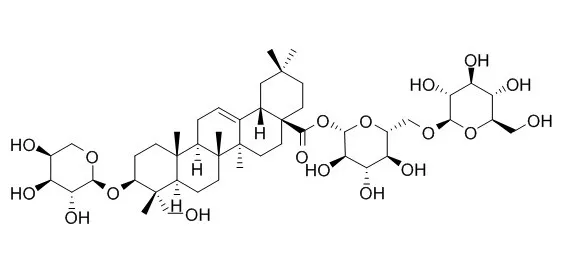| Description: |
Asperosaponin VI has antioxidant activity, it shows protective effect against hypoxia-induced cardiomyocytes apoptosis probably by activating the PI3K/Akt and CREB pathways, it also plays protective roles on acute myocardial infarction in rats. Asperosaponin VI may induce osteoblast maturation and differentiation, and then increase bone formation via increasing BMP-2 synthesis, and activating p38 and ERK1/2. |
| Targets: |
p38MAPK | ERK | Bcl-2/Bax | Akt | cAMP | Caspase | PI3K | BMP-2 | p-CREB |
| In vitro: |
| Phytother Res. 2011 Nov;25(11):1700-6. | | Asperosaponin VI, a saponin component from Dipsacus asper wall, induces osteoblast differentiation through bone morphogenetic protein-2/p38 and extracellular signal-regulated kinase 1/2 pathway.[Pubmed: 21452371 ] | Osteoporosis is a reduction in skeletal mass because of the loss of osteoblastic activity or an increase in osteoclastic activity. The survival of osteoblast cells plays a crucial role in the development of osteoporosis.
METHODS AND RESULTS:
Asperosaponin VI (ASA VI) is a kind of saponin in the medicinal herb Dipsacus asper Wall which has long been used as an antiosteoporosis drug. The assay of cell proliferation, alkaline phosphatase (ALP) activity and measurement of mineralized matrix, showed that ASA VI exhibited a significant induction of proliferation, differentiation and mineralization in MC3T3-E1 and primary osteoblastic cells. Induction of differentiation by ASA VI was associated with increased bone morphogenetic protein-2 (BMP-2), indicating that BMP-2 is essential in ASA VI to mediate osteoblast maturation and differentiation. In addition, ASA VI may induce differentiation by increasing the activity of p38 and ERK1/2.
CONCLUSIONS:
In conclusion, ASA VI may induce osteoblast maturation and differentiation, and then increase bone formation via increasing BMP-2 synthesis, and activating p38 and ERK1/2. |
|
| In vivo: |
| Eur J Pharmacol. 2010 Feb 10;627(1-3):235-41. | | Protective roles of Asperosaponin VI, a triterpene saponin isolated from Dipsacus asper Wall on acute myocardial infarction in rats.[Pubmed: 19909736 ] | Asperosaponin VI is a saponin of the medicinal herb Dipsacus asper (Xuduan), and no pharmacological activity has been reported yet. In this study, we investigated the anti-myocardial ischemia effects of Asperosaponin VI (ASA VI) both in vivo and in vitro.
METHODS AND RESULTS:
An animal model of myocardial ischemia(MI) injury was induced by coronary occlusion, pretreatment with ASA VI (10 and 20mg/kg, i.v.) could protect the heart from ischemia injury by decreasing the levels of creatine kinase-MB (CK-MB), lactate dehydrogenase (LDH), glutamic oxalacetic transaminase (GOT) and cardiac troponin T (cTnT) in serum, increasing the levels of catalase, glutathione peroxidase (GSH-Px) and superoxide dismutase (SOD) levels in heart, and decreasing that of malondialdehyde (MDA) level in acute MI rats. ASA VI also raised the activities of mitochondrial enzymes (succinate dehydrogenase (SDH), isocitrate dehydrogenase (ICDH), malate dehydrogenase (MDH) and alpha-ketoglutarate dehydrogenase (alpha-KGDH)) and those of adenosine triphosphate (ATP) content, but lowered Ca(2+) level. Electrocardiograph parameters and histopathological observations demonstrated the same protective effects. In vitro experiment, neonatal rat cardiomyocytes were incubated to test the direct cytoprotective effect of ASA VI against H(2)O(2) exposure. Pretreatment with ASA VI (30 and 60 microg/ml) prior to H(2)O(2) exposure increased cell viability and inhibited H(2)O(2)-induced reactive oxygen species increase. ASA VI (15, 30 and 60 microg/ml) also increased the activities of LDH in the cultured supernatant and SOD in cardiomyocytes, but decreased the cardiomyocytes MDA level.
CONCLUSIONS:
Our results suggested that ASA VI could provide significant cardioprotective effects against acute MI in rats. The mechanisms might be attributed to scavenging lipid peroxidation products and reactive oxygen species, increasing antioxidant defense enzymes and preventing mitochondrial damage. |
|






 Cell. 2018 Jan 11;172(1-2):249-261.e12. doi: 10.1016/j.cell.2017.12.019.IF=36.216(2019)
Cell. 2018 Jan 11;172(1-2):249-261.e12. doi: 10.1016/j.cell.2017.12.019.IF=36.216(2019) Cell Metab. 2020 Mar 3;31(3):534-548.e5. doi: 10.1016/j.cmet.2020.01.002.IF=22.415(2019)
Cell Metab. 2020 Mar 3;31(3):534-548.e5. doi: 10.1016/j.cmet.2020.01.002.IF=22.415(2019) Mol Cell. 2017 Nov 16;68(4):673-685.e6. doi: 10.1016/j.molcel.2017.10.022.IF=14.548(2019)
Mol Cell. 2017 Nov 16;68(4):673-685.e6. doi: 10.1016/j.molcel.2017.10.022.IF=14.548(2019)